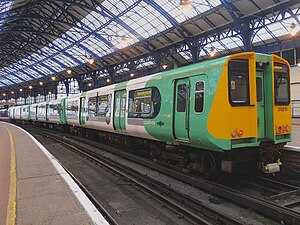British Rail Class 313
| British Rail Class 313 | |
|---|---|

|
|

The interior of a Southern refurbished Class 313/2
|
|
| In service | 1976 - Current |
| Manufacturer | British Rail Engineering Limited |
| Built at | BREL York Works |
| Family name | BREL 1972 "PEP" |
| Constructed | 1976 - 1977 |
| Entered service | 16 August 1976 |
| Refurbishment | 23 Silverlink sets 1997-2001 41 WAGN sets 1999-2003 19 Southern sets 2010-2011 |
| Number built | 64 sets |
| Formation | 3 cars per set (DMSO-PTSO-DMSO) |
| Capacity | 232 seats (as built) 231 seats (Great Northern) 228 seats (Silverlink) 202 seats (London Overground) 194 seats (Southern) |
| Operator(s) | GTR (Southern), GTR (Great Northern) |
| Depot(s) |
Hornsey |
| Line(s) served |
East Coast Main Line Hertford Loop West Coastway East Coastway |
| Specifications | |
| Train length | 60.83 m (199 ft 6 7⁄8 in) |
| Car length | DMS 20.33 m (66 ft 8 in) TS 19.92 m (65 ft 4 in) |
| Width | 2.82 m (9 ft 3 in) |
| Height | 3.58 m (11 ft 9 in) |
| Floor height | 1156 mm |
| Maximum speed |
75 mph (121 km/h) 30 mph (48 km/h) GN units on DC |
| Weight | 104.5 tonnes (102.8 long tons) |
| Power output | 656 kW (880 hp) |
| Electric system(s) |
25 kV 50 Hz AC Overhead 750 V DC 3rd rail |
| Current collection method | Pantograph |
| UIC classification | Bo-Bo + 2-2 + Bo-Bo |
| Bogies | BX1 |
| Coupling system | Tightlock |
| Track gauge | 1,435 mm (4 ft 8 1⁄2 in) standard gauge |
75 mph (121 km/h)
The Class 313 is a type of dual-voltage electric multiple unit (EMU) train built by BREL York Works between February 1976 and April 1977. They were the first second-generation EMUs to be constructed for British Rail and the first British Rail units with both a pantograph for 25 kV AC overhead lines and shoegear for 750 V DC third rail supply. They were the first units in Britain to have multi-function Tightlock couplers, allowing coupling and the connection of control electric and air supplies to be carried out from the cab.
Following the withdrawal of most first-generation stock, they are the oldest EMUs in regular service on National Rail on the British mainland; the oldest units are now 40 years old. The Great Northern examples are due to be replaced from 2018 by new six-carriage Class 717 trains.
The Class 313 was developed following extensive trials with the prototype Class 445 "PEP" built in the early 1970s. The 313 is similar to the Class 314 (Glasgow), Class 315 (Anglia suburban — east London), Class 507 (Merseyside) and Class 508 (Merseyside, formerly Southern Region).
Since they were designed for use on Great Northern Suburban Inner Suburban services from Moorgate to Welwyn Garden City or Hertford North, Letchworth Garden City which included a section of 'tube' line built to take standard size trains between Drayton Park and Moorgate, they are built to a slightly smaller loading gauge than conventional trains. They are standard length and width, but the roof is lower, most noticeable due to the lack of a "well" for the Stone Faiveley AMBR pantograph on the centre coach. They have to comply with regulations for underground trains, such as having doors at each end of the train for evacuation onto the tracks, and when on 750 V DC supply the traction supply for each motor coach is separate, whereas on conventional 750 V DC trains each coach in a unit is linked by a 750 V bus line. Due to this, each motor coach has shoe gear on both bogies, whereas normally it would only be on the leading bogie. They are fitted with trip-cocks that are struck by a raised train-stop arm at red signals and will apply the brakes if the train passes one.
...
Wikipedia
